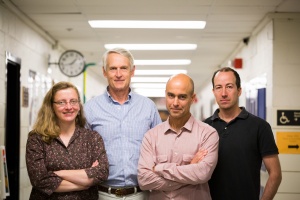Oct 10 2013
The Royal Swedish Academy of Sciences today awarded the Nobel Prize in physics to theorists Peter Higgs and Francois Englert to recognize their work developing the theory of what is now known as the Higgs field, which gives elementary particles mass.
 Members of Penn's ATLAS team Evelyn Thomson, Brig Williams, Joseph Kroll and Elliot Lipeles. (Photo: Scott Spitzer)
Members of Penn's ATLAS team Evelyn Thomson, Brig Williams, Joseph Kroll and Elliot Lipeles. (Photo: Scott Spitzer)
Thousands of scientists from around the world played a significant role in discovering the particle that proves the existence of the Higgs field, the Higgs boson. Brig Williams, Joseph Kroll, Elliot Lipeles and Evelyn Thomson, professors of physics in the University of Pennsylvania’s School of Arts and Sciences, along with their students, postdoctoral fellows and technical staff, have played a large role in the design and construction of ATLAS, one of the two main particle detectors responsible for the discovery, and in the observation of the particles into which the Higgs boson decays.
“Being a part of this monumental discovery has been the experience of a lifetime and the culmination of decades of work for us,“ said Williams. “It is especially gratifying to me that the graduate students and postdoctoral fellows played such a large role. “
"Higgs and Englert elegantly solved a key question by positing the existence of a new particle, now known as the Higgs boson,” Lipeles said. “Our work in searching for and ultimately detecting the Higgs was driven by the important role the particle plays in the theory of particle interactions. It is not clear whether we would have found this particle without the prediction, or even built an accelerator such as the Large Hadron Collider capable of finding it. The combination of the theoretical prediction and the experimental detection is truly a triumph for science."
In the 1960s, Higgs and Englert, along with other theorists, including Robert Brout, Tom Kibble and Carl Hagen and Gerald Guralnik, published papers introducing key concepts in the theory of the Higgs field. On July 4, 2012, scientists on the international ATLAS and CMS experiments, performed at the LHC at CERN laboratory in Europe, confirmed this theory when they announced the discovery of the Higgs boson.
The LHC works by accelerating protons around its 17-mile-long circular track in opposite directions. When the beams are crossed inside the detectors, the protons collide in a huge explosion of energy that can create new particles. The problem inherent in trying to detect the a Higgs boson is that, as soon as the particle is created, it immediately breaks apart into different particles that fly off in different directions.
Penn’s main contributions to the ATLAS detector were in developing the electronics that help capture the results of those proton collision outcomes in its inner detector, as well as a process that helps the researchers record only the most noteworthy collisions, as millions of them occur every second.
By tracing the energy and trajectory of this sub-atomic shrapnel as it passes through the detectors, researchers were able to piece together the mass of the original particle. One group within the Penn team worked backwards from a process that would turn a Higgs into a pair of photons; Another part of the Penn team worked on detecting the Higgs boson becoming a pair of W-bosons, a kind of exotic sub-atomic particle similar to the photon but more massive and electrically charged.
A total of 89 U.S. universities and seven U.S. Department of Energy laboratories participated in the ATLAS and CMS experiments. The Department of Energy’s Brookhaven National Laboratory serves as the U.S. hub for the ATLAS experiment and Fermilab serves as the U.S. center for the CMS experiment.
"It’s wonderful to see a 50-year-old theory confirmed after decades of hard work and remarkable ingenuity," said Brookhaven National Laboratory Director Doon Gibbs. "The U.S. has played a key role, contributing scientific and technical expertise along with essential computing and data analysis capabilities—all of which were necessary to bring the Higgs out of hiding. It’s a privilege to share in the success of an experiment that has changed the face of science."